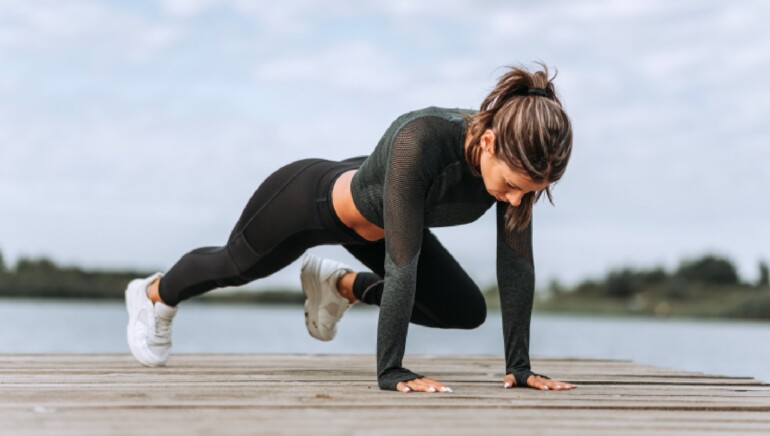Exercising to Lose Weight
What exercises do the most to lose weight?
Effective weight loss exercises typically involve a combination of cardiovascular exercise, strength training, and flexibility exercises. Here are some exercises that can help with weight loss:
- Cardiovascular exercises: These exercises help burn calories and improve heart health. Examples include:
Cardiovascular exercises, also known as aerobic exercises, are activities that increase your heart rate and breathing rate, improving the efficiency of your cardiovascular system. These exercises help strengthen the heart, lungs, and muscles, enhance endurance, and promote overall health. Here are some common cardiovascular exercises:
- Walking:
- Walking is a simple and accessible exercise that can be done almost anywhere, indoors or outdoors. It’s suitable for people of all fitness levels and can be easily incorporated into daily routines.
- Running or Jogging:
- Running or jogging is a higher-intensity cardiovascular exercise that helps improve cardiovascular fitness and burn calories. It can be done on a treadmill or outdoors.
- Cycling:
- Cycling, whether on a stationary bike or outdoors, is an excellent low-impact cardiovascular exercise that strengthens the legs and improves endurance.
- Swimming:
- Swimming is a full-body workout that engages multiple muscle groups while providing a low-impact cardiovascular workout. It’s particularly beneficial for individuals with joint pain or mobility issues.
- Elliptical Training:
- Elliptical trainers provide a low-impact, weight-bearing cardiovascular workout that simulates walking, running, or stair climbing. They are suitable for people of all fitness levels.
- Rowing:
- Rowing machines provide a full-body cardiovascular workout that engages the legs, core, arms, and back muscles. It’s an excellent option for building endurance and strength.
- Jumping Rope:
- Jumping rope is a high-intensity cardiovascular exercise that improves coordination, agility, and cardiovascular fitness. It can be done almost anywhere with minimal equipment.
- High-Intensity Interval Training (HIIT):
- HIIT involves alternating between short bursts of high-intensity exercise and periods of rest or low-intensity exercise. It’s an effective way to improve cardiovascular fitness, burn calories, and increase metabolism in a shorter amount of time.
- Dancing:
- Dancing is a fun and enjoyable way to get your heart rate up while improving coordination, balance, and flexibility. There are many different styles of dance, from ballroom to Zumba, to suit various preferences and fitness levels.
- Stair Climbing:
- Climbing stairs is an effective cardiovascular exercise that strengthens the lower body and elevates the heart rate. It can be done on a stair climber machine or by using stairs in your home or office building.
When choosing cardiovascular exercises, it’s essential to select activities that you enjoy and that fit your fitness level and physical condition. Aim for at least 150 minutes of moderate-intensity aerobic exercise or 75 minutes of vigorous-intensity aerobic exercise per week, along with muscle-strengthening activities on two or more days per week, as recommended by health guidelines.
What are some strength training exercises?
Strength training exercises are activities that target specific muscle groups to build strength, increase muscle mass, and improve overall muscular endurance. Incorporating strength training into your fitness routine can help enhance athletic performance, support healthy aging, and reduce the risk of injury. Here are some common strength training exercises categorized by muscle group:
Upper Body Exercises:
- Push-Ups:
- Target Muscles: Chest, shoulders, triceps.
- Variations: Standard push-ups, incline push-ups, decline push-ups, diamond push-ups.
- Pull-Ups/Chin-Ups:
- Target Muscles: Back, biceps, shoulders.
- Variations: Wide grip, narrow grip, assisted pull-ups.
- Bent-Over Rows:
- Target Muscles: Upper back (latissimus dorsi, rhomboids), biceps.
- Equipment: Dumbbells, barbell, resistance bands.
- Bench Press:
- Target Muscles: Chest, shoulders, triceps.
- Equipment: Barbell, dumbbells, resistance bands.
- Shoulder Press:
- Target Muscles: Shoulders, triceps.
- Equipment: Dumbbells, barbell, resistance bands.
- Bicep Curls:
- Target Muscles: Biceps.
- Equipment: Dumbbells, barbell, resistance bands.
- Tricep Dips:
- Target Muscles: Triceps, shoulders.
- Equipment: Dip bars, bench.
Lower Body Exercises:
- Squats:
- Target Muscles: Quadriceps, hamstrings, glutes.
- Variations: Bodyweight squats, goblet squats, front squats, back squats.
- Lunges:
- Target Muscles: Quadriceps, hamstrings, glutes.
- Variations: Forward lunges, reverse lunges, walking lunges, side lunges.
- Deadlifts:
- Target Muscles: Hamstrings, glutes, lower back, upper back.
- Equipment: Barbell, dumbbells, kettlebells.
- Leg Press:
- Target Muscles: Quadriceps, hamstrings, glutes.
- Equipment: Leg press machine.
- Calf Raises:
- Target Muscles: Calves.
- Variations: Standing calf raises, seated calf raises, single-leg calf raises.
- Glute Bridges:
- Target Muscles: Glutes, hamstrings.
- Variations: Bodyweight glute bridges, weighted glute bridges, single-leg glute bridges.
Core Exercises:
- Planks:
- Target Muscles: Core muscles (abdominals, obliques, lower back).
- Variations: Forearm plank, high plank, side plank, plank with leg lift.
- Russian Twists:
- Target Muscles: Obliques, core.
- Equipment: Medicine ball, dumbbell, kettlebell.
- Leg Raises:
- Target Muscles: Lower abs, hip flexors.
- Variations: Hanging leg raises, lying leg raises.
- Crunches:
- Target Muscles: Upper abs.
- Variations: Standard crunches, bicycle crunches, reverse crunches.
- Woodchoppers:
- Target Muscles: Obliques, core.
- Equipment: Cable machine, resistance band.
Full Body Exercises:
- Kettlebell Swings:
- Target Muscles: Glutes, hamstrings, core, shoulders.
- Equipment: Kettlebell.
- Burpees:
- Target Muscles: Full body (legs, chest, arms, core).
- Equipment: Bodyweight.
- Medicine Ball Slams:
- Target Muscles: Full body (core, shoulders, arms).
- Equipment: Medicine ball.
- Renegade Rows:
- Target Muscles: Core, back, shoulders, arms.
- Equipment: Dumbbells.
- Mountain Climbers:
- Target Muscles: Core, shoulders, legs.
- Equipment: None (bodyweight exercise).
When performing strength training exercises, focus on proper form, controlled movements, and gradually increasing resistance or intensity over time to continue challenging your muscles and promoting strength gains. It’s also essential to allow for adequate rest and recovery between workouts and to incorporate a variety of exercises to target different muscle groups and prevent overuse injuries.




